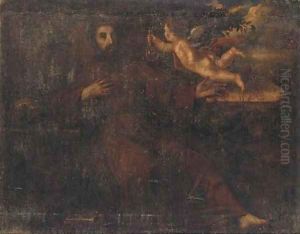Of Francisco De Ribalta Paintings
Francisco de Ribalta was a Spanish painter, born in 1565 in Solsona, Catalonia. He is considered one of the most important figures of the Spanish Baroque period, particularly known for his religious paintings and his role in the transition from Mannerism to Baroque styles. Ribalta's precise birth date is not documented, but his baptism is recorded as June 2, 1565.
Ribalta began his artistic training in his early years, and around the age of 14, he moved to Valencia, which would become the main stage for his artistic development. There, he was likely influenced by the work of the Italian painter Federico Zuccaro, who spent some time in Spain. However, Ribalta's style evolved significantly throughout his career, ultimately showing a strong influence from Caravaggio, whose work he may have encountered through the Italian's followers in Spain or possibly through a trip to Italy, although such a journey is not definitively recorded.
By the late 1580s, Ribalta had established himself in Valencia and married Inés Pelayo, with whom he had his son Juan Ribalta, who would also become a painter. Francisco de Ribalta became a leading painter in Valencia and was much sought after for altarpieces and religious commissions. His works are characterized by dramatic chiaroscuro, emotional intensity, and a realistic approach to human figures and expressions.
One of his most famous works is the 'Christ Embracing St. Bernard,' which is a prime example of his mature style and his ability to convey deep spiritual and emotional experiences. His paintings often featured a single source of light that would illuminate the scene, highlighting the spiritual enlightenment within his religious subjects.
Ribalta's influence extended beyond his own work, as he became a teacher and mentor to other artists. His son, Juan Ribalta, was among his pupils and inherited his father's workshop after his death. Other students and followers who were affected by Ribalta's style include Vicente Castelló and Jerónimo Jacinto de Espinosa.
Francisco de Ribalta passed away on January 14, 1628, in Valencia. His legacy lived on through his son and the other artists he influenced, helping to cement the Baroque style in Spanish painting. Today, Ribalta's works are housed in various museums and collections around the world, including the Prado Museum in Madrid and the Valencia Museum of Fine Arts, as well as in numerous churches where his altarpieces continue to inspire viewers.
